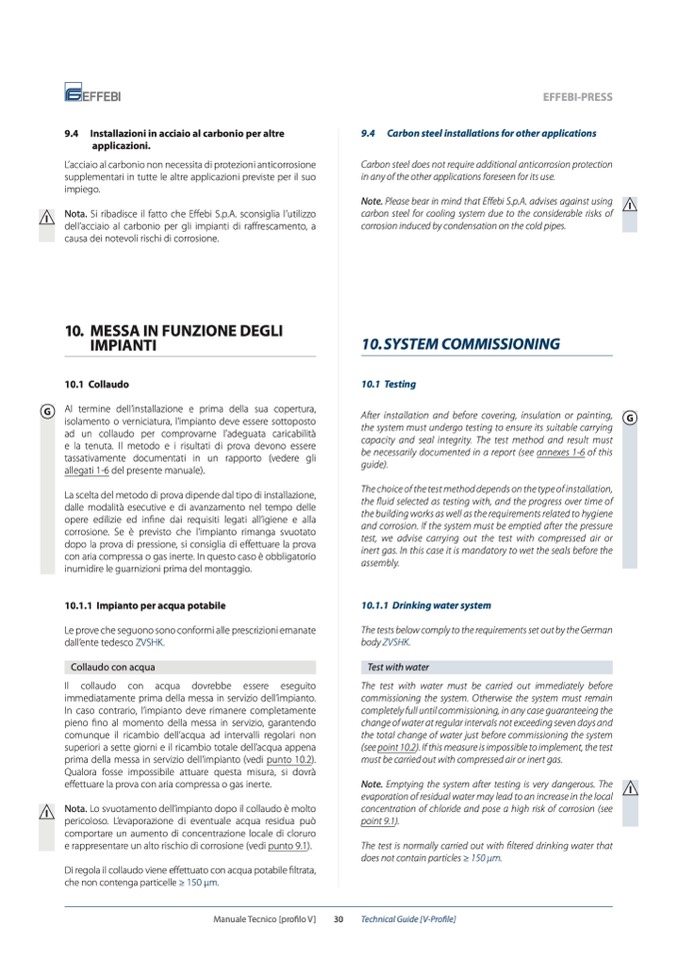
9.4 Installazioni in acciaio al carbonio per altre
applicazioni.
L’acciaio al carbonio non necessita di protezioni anticorrosione
supplementari in tutte le altre applicazioni previste per il suo
impiego.
Nota. Si ribadisce il fatto che Effebi S.p.A. sconsiglia l’utilizzo
dell’acciaio al carbonio per gli impianti di raffrescamento, a
causa dei notevoli rischi di corrosione.
10. MESSA IN FUNZIONE DEGLI
IMPIANTI
10.1 Collaudo
Al termine dell’installazione e prima della sua copertura,
isolamento o verniciatura, l’impianto deve essere sottoposto
ad un collaudo per comprovarne l’adeguata caricabilità
e la tenuta. Il metodo e i risultati di prova devono essere
tassativamente documentati in un rapporto (vedere gli
allegati 1-6 del presente manuale).
La scelta del metodo di prova dipende dal tipo di installazione,
dalle modalità esecutive e di avanzamento nel tempo delle
opere edilizie ed infine dai requisiti legati all’igiene e alla
corrosione. Se è previsto che l’impianto rimanga svuotato
dopo la prova di pressione, si consiglia di effettuare la prova
con aria compressa o gas inerte. In questo caso è obbligatorio
inumidire le guarnizioni prima del montaggio.
10.1.1 Impianto per acqua potabile
Le prove che seguono sono conformi alle prescrizioni emanate
dall’ente tedesco ZVSHK.
Collaudo con acqua
Il collaudo con acqua dovrebbe essere eseguito
immediatamente prima della messa in servizio dell’impianto.
In caso contrario, l’impianto deve rimanere completamente
pieno fino al momento della messa in servizio, garantendo
comunque il ricambio dell’acqua ad intervalli regolari non
superiori a sette giorni e il ricambio totale dell’acqua appena
prima della messa in servizio dell’impianto (vedi punto 10.2).
Qualora fosse impossibile attuare questa misura, si dovrà
effettuare la prova con aria compressa o gas inerte.
Nota. Lo svuotamento dell’impianto dopo il collaudo è molto
pericoloso. L’evaporazione di eventuale acqua residua può
comportare un aumento di concentrazione locale di cloruro
e rappresentare un alto rischio di corrosione (vedi punto 9.1).
Di regola il collaudo viene effettuato con acqua potabile filtrata,
che non contenga particelle ≥ 150 μm.
EFFEBI-PRESS
9.4 Carbon steel installations for other applications
Carbon steel does not require additional anticorrosion protection
in any of the other applications foreseen for its use.
Note. Please bear in mind that Effebi S.p.A. advises against using
carbon steel for cooling system due to the considerable risks of
corrosion induced by condensation on the cold pipes.
10.SYSTEM COMMISSIONING
10.1 Testing
After installation and before covering, insulation or painting,
the system must undergo testing to ensure its suitable carrying
capacity and seal integrity. The test method and result must
be necessarily documented in a report (see annexes 1-6 of this
guide).
The choice of the test method depends on the type of installation,
the fluid selected as testing with, and the progress over time of
the building works as well as the requirements related to hygiene
and corrosion. If the system must be emptied after the pressure
test, we advise carrying out the test with compressed air or
inert gas. In this case it is mandatory to wet the seals before the
assembly.
10.1.1 Drinking water system
The tests below comply to the requirements set out by the German
body ZVSHK.
Test with water
The test with water must be carried out immediately before
commissioning the system. Otherwise the system must remain
completely full until commissioning, in any case guaranteeing the
change of water at regular intervals not exceeding seven days and
the total change of water just before commissioning the system
(see point 10.2). If this measure is impossible to implement, the test
must be carried out with compressed air or inert gas.
Note. Emptying the system after testing is very dangerous. The
evaporation of residual water may lead to an increase in the local
concentration of chloride and pose a high risk of corrosion (see
point 9.1).
The test is normally carried out with filtered drinking water that
does not contain particles ≥ 150 μm.
I
I
G
G
I
I
Manuale Tecnico [profilo V]
30
Technical Guide [V-Profile]

